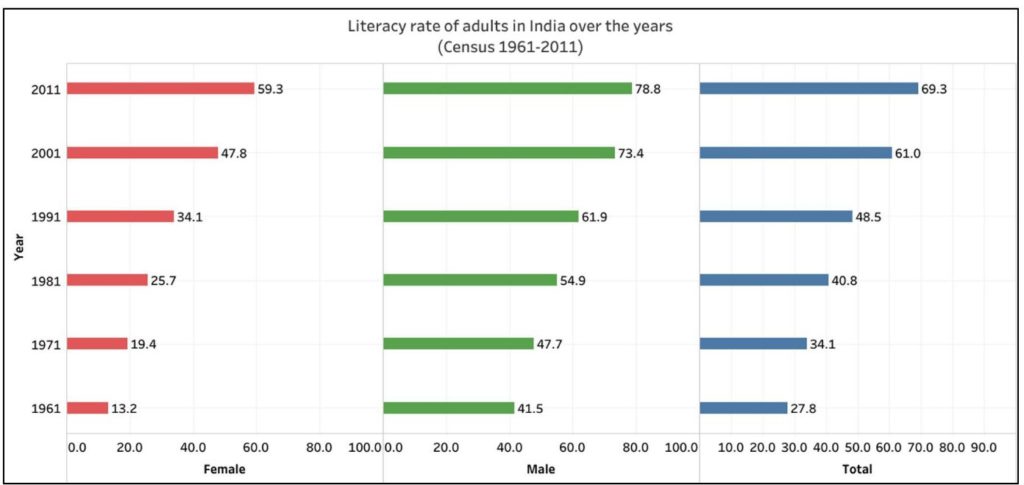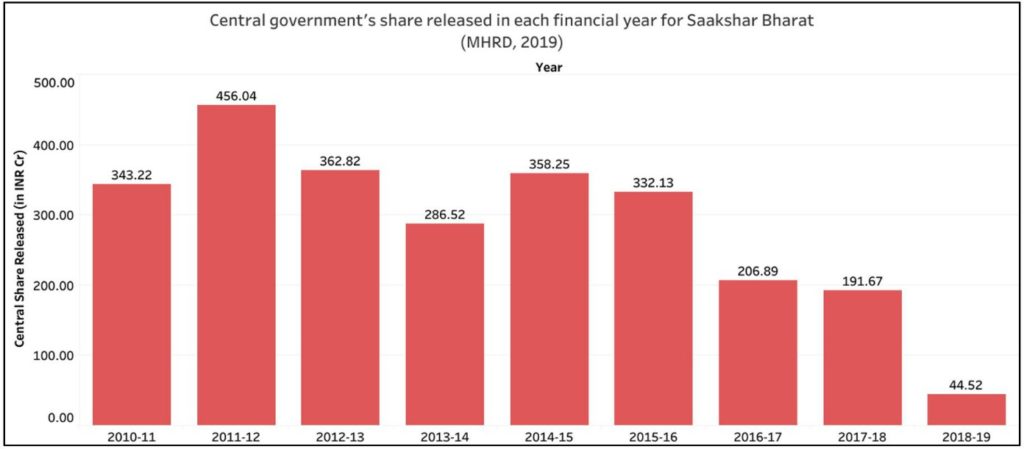[orc]India made considerable progress in ‘Adult Literacy’ in the last few decades. However, as per the 2011 Census, close to 24 crore adults are yet to attain literacy. The Government’s ‘Saakshar Bharat’ programme, a revised version of NLM launched in 2009, is aimed at increasing adult literacy. Here is a review of the programme.
According to Census 2011, only 69.3% of the adults above the age of 15 years in India are literate. In other words, 30.7% of them or close to 24 crore adults are illiterate as a result of numerous social and economic factors persistent in the country. The government of India upon realising the need to educate the adults introduced the National Literacy Mission (NLM) in 1988, aimed at imparting functional literacy to non-literates in the age group of 15 to 35 years. The scheme was later revamped to address its shortcomings and meet the changing demands. Saakshar Bharat Programme, modified version of NLM, was launched more than a decade ago with the objective of reaching 80% literacy level by providing an opportunity to those aged 15 years & beyond and those who are non-literate and non-numerate. In this story, we look at the programme in detail and the related data.
24 Crore adults in India are not literate as per census 2011

As per the Census 2011, India’s literacy rate stood at 74% with male literacy at 82.1% and female literacy at 65.5%. However, in the case of adults aged 15 and above, the literacy rate among men is 78.8% and that among women is 59.3%. As is evident from the chart, the literacy rates of adults (both men and women) has been increasing with every census. Despite the progress made, about 24 crore adults are not literate in India as per the Census 2011.
The gender gap in terms of adult literacy is observed to be decreasing with time. However, the disparity in adult literacy is stark between Urban & Rural areas. Literacy rate of urban adults is 82.8% and that of rural adults is 62.6%. It is also observed that gender disparity in the urban areas is lesser than that in the rural backdrop.
Saakshar Bharat was launched in 2009 to improve the literacy rate among Adults
On International Literacy Day which falls on 08 September every year, the then Prime Minister Dr. Manmohan Singh launched the Saakshar Bharat Programme in 2009 during the 11th five year plan. The centrally sponsored scheme is implemented by the Department of School Education and Literacy (DSEL) of the Ministry of Human Resource Development (MHRD). The nodal agency of the scheme at the national level is the National Literacy Mission Authority.
Unlike the previous scheme, Saakshar Bharat offered opportunities for people to continue with their education
The objectives of the scheme, similar to the erstwhile NLM, include imparting functional reading, writing and mathematical skills which are required in the day to day life, to those adults who are devoid of any formal education in their childhood due to a multitude of reasons. In addition, Saakshar Bharat also gives them an opportunity to continue their education and offers skill development programs. To minimise the gender gap, social gap as well as inter and intra state disparities in literacy levels, prominence has been given to females, people belonging to Scheduled Castes, Scheduled Tribes and other minorities, especially in the rural backdrop.
7.62 crore adults across 410 districts have been educated under the scheme
Saakshar Bharat was implemented from October 2009 in districts with female literacy rate 50% and below based on Census 2001 data. Left wing extremism affected districts were also included in the programme irrespective of the literacy rate. The programme had a target to impart basic education to at least 7 crore adults including 1.4 crore people belonging to ‘Scheduled Caste’ category and 80 lakh people belonging to ‘Scheduled Tribe’ category.
According to numbers presented by MHRD in the Lok Sabha earlier this year, 7.64 crore adults were certified as literates between August 2010 and March 2018. Of this, Uttar Pradesh and Bihar together constitute 36%. The programme covered 410 districts across 26 states in the country. Kerala, Goa and Mizoram are the three excluded states. Female literacy rates in these three states are the highest in the country as per Census 2011. Considering the census 2011 numbers and the coverage of the scheme, around 16 crore adults would still lack literacy.
Adult Education Centres have been set up in Gram Panchayats
Adult Education Centres (AEC) or Lok Shiksha Kendras were set up to implement the programme at the grass root level. In each gram panchayat with a minimum population of 5000, at least one AEC has been established and is led by two paid coordinators called ‘Preraks’. Preference to the post of ‘Prerak’ was to be given to women and marginal groups. In urban areas, the programme is implemented through Jan Shikshan Sansthans, NGOs, State Resource Centres and other institutions which have been identified by NLM Authority.

Under the scheme, there are four different programmes with specific objectives
Functional Literacy Programme, Basic Education Programme, Vocational Education and Continuing Education Programme are the programmes offered by the government to meet the objectives of Saakshar Bharat.
- Functional Literacy Programme aims to teach people to read, write and do arithmetic.
- The Basic Education Programme helps in attaining knowledge and skills equivalent to classes 3 to 8 to those who wish to acquire post functional literacy.
- Vocational Education Programme, as its name suggests, equips those interested, with skills to improve their income.
- Continuing Education Programme provides facilities such as libraries and reading rooms where thematic short-term courses are held on relevant topics.
Bi-annual examinations are conducted to assess those who are engaged in the programme
To assess the competency of those engaged in the programme, based on the rules and guidelines put forth by the National Institute for Open Schooling, Basic Literacy Assessments are conducted twice in a year based on the results of which certification of literates takes place.
Funds for the programme dry up in 2018-19 since operation period of the program has ended
The central government has released over Rs. 2,500 crore for the programme since 2010 out of the total approved grant amount of Rs. 6000 crore as revealed by Lok Sabha answers. From Rs. 456 crore in 2011-12, the last financial year (2018-19) saw an expenditure of Rs. 44.52 crores for the programme. The scheme was originally planned to be operational up to 31 March 2012 (12th five year planning period). It was later extended up to 31 March 2018. Many lost their jobs which led to protests when the program came to an end in 2018. There have been reports that a new scheme ‘Padhna Likhna Abhiyan’ will be rolled out replacing Saakshar Bharat. Whether Saakshar Bharat bore fruits or not, will be revealed in the upcoming 2021 census results.

Literacy empowers people along with other positive social and economic impact
Not only does literacy empower people, it also helps eradicate poverty by impacting their well-being, informed decision making and employability. Investing in adult education will also benefit the future generations. Literacy helps bolster the results of other social development schemes and initiatives. One of the targets of the United Nations’ Sustainable Development Goal 4 on Quality Education is to eliminate the gender gap in literacy by 2030. Ensuring education is accessible by all is also a part of this goal.
Samagra Siksha is an integrated scheme introduced last year
Since 2018-19, the Department of School Education and Literacy introduced Samagra Shiksha which is an amalgamation of the erstwhile schemes of Sarva Shiksha Abhiyan (SSA), Rashtriya Madhyamik Shiksha Abhiyan (RMSA) and Teacher Education (TE). Samagra Shiksha is also a centrally sponsored scheme which covers all classes from pre-school to class 12 under one head. Through this scheme, the government aims to ensure inclusive and equitable education for all children including transgender and minorities.



1 Comment
Pingback: Adult Literacy: Reviewing the ‘Saakshar Bharat’ programme - Fact Checking Tools | Factbase.us